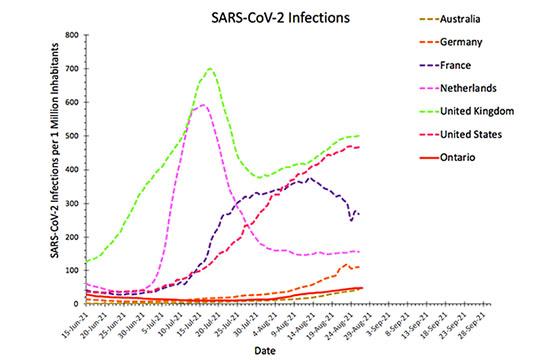The COVID-19 Science Advisory Table — a group of experts who report on emerging evidence to inform the Ontario government’s pandemic response — recently released its COVID-19 projections for fall. This comes nearly two weeks after David Fisman, a former prominent member of the table and professor at U of T, resigned, alleging that the table was withholding “grim” modelling from the public.
In the resignation letter that he posted on Twitter, Fisman claimed that the table’s transparency had been affected by political considerations, and that he felt uncomfortable working with the group after having publicly contradicted their guidelines.
In a tweet, the table countered, saying that it had not withheld any consensus models from the public.
Modelling considerations
In an interview with The Varsity, Robert Steiner, the table’s director of communications, said that at the time of Fisman’s resignation, experts were still reviewing various models and attempting to come to a consensus on COVID-19 fall projections.
According to Steiner, the table works to produce information that is clear and relevant for policymakers. While it does release all its findings to the public, it also makes sure to highlight information that is important to the average person as well as public health professionals.
Steiner explained that experts needed to make assumptions about factors such as infection rate and vaccine efficacy, due in part to the novelty of COVID-19. As a result, the table had to take a range of results into consideration when forming a consensus model that it could release to the public.
In regard to Fisman’s allegations, Steiner echoed the suggestion made by Peter Jüni, the table’s scientific director. Jüni suggested that Fisman was referring to a specific model with a very specific set of implications. Steiner noted that the table would not release that one model because it might not be in line with the other models it was reviewing and therefore would not reflect the bigger picture.
Members of the table have also stated that the models were delayed because experts took some time off during the summer. Steiner said that this was to help them cope with burnout, and that “over the course of the next week or two, [we’ll] be coming back fully into this work.”
Consensus model
The consensus model, released in the table’s briefing on September 1, confirms that Ontario is in the midst of a fourth wave.
It also noted that vaccinated individuals were less likely to become severely ill from COVID-19, but that the rate of vaccination would need to accelerate in order to fight against the Delta variant and prevent another lockdown. Other measures, such as physical distancing, capacity limits, and masking, will also be necessary.
The briefing included a section on the Delta variant, which spreads much faster than the original virus, and a prediction that if transmission is not reduced, intensive care unit occupancy may exceed that recorded during the third wave by October.
The Ontario government recently announced a vaccine passport system to track vaccinations, which will go into effect on September 22. However, the province will not require physical distancing or capacity limits in instructional spaces as long as stringent masking and vaccination requirements are in place. U of T has stated that it will follow the public health guidelines provided by the government.


